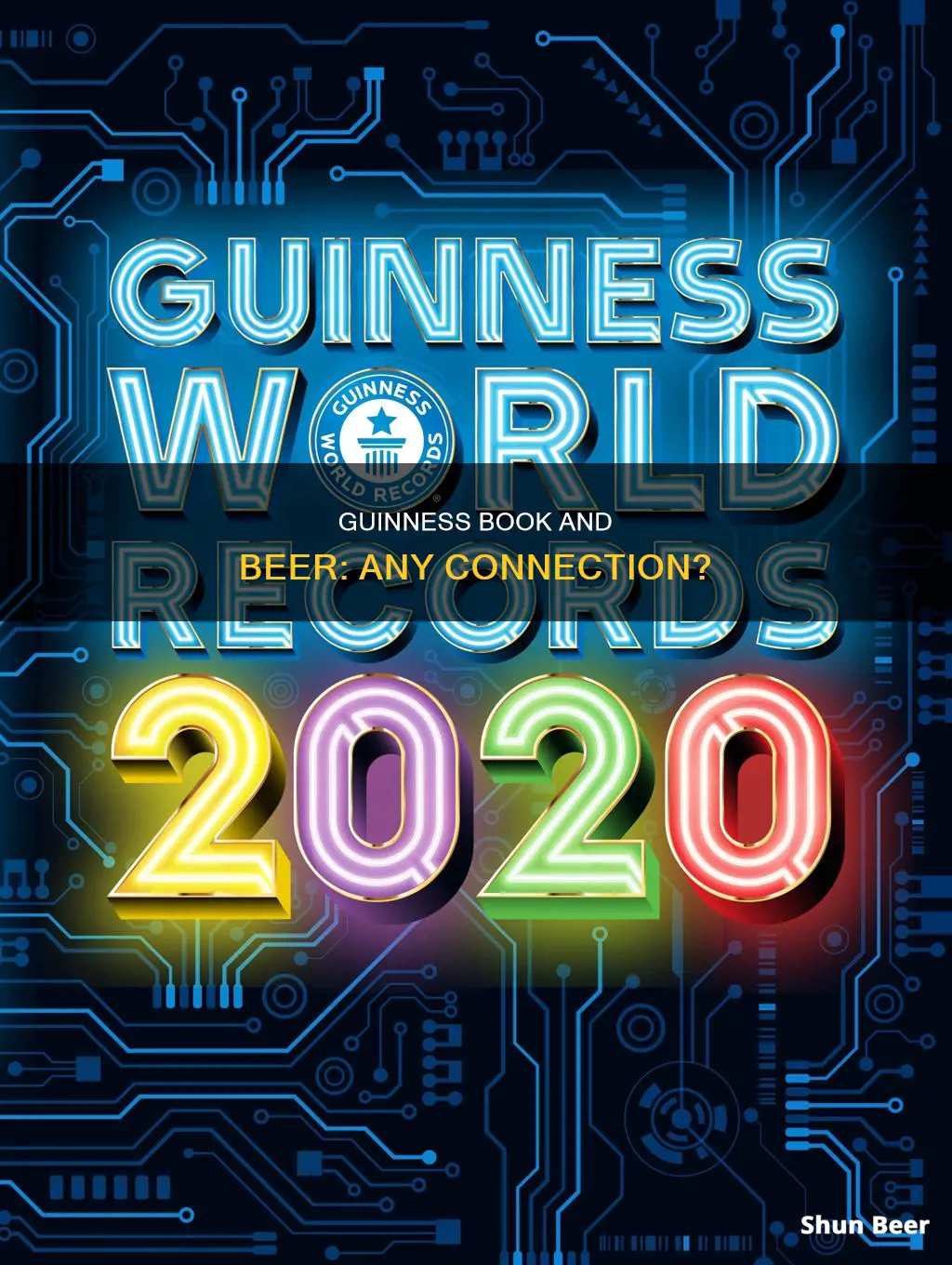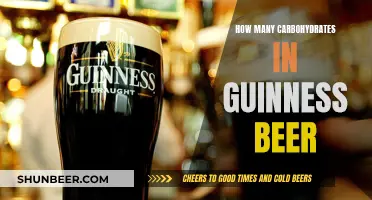
The Guinness Book of World Records and Guinness beer are intimately tied. The Guinness brewery, which first launched in Ireland in the 1700s, is responsible for the creation of the famous book of records. The idea for the book came about in the early 1950s when Sir Hugh Beaver, the then managing director of the Guinness Brewery, wanted to settle a dispute about the fastest game bird in Europe. After failing to find an answer in any reference book, Beaver decided to create one. He invited the fact-finding researchers Norris and Ross McWhirter to compile a book of facts and figures, and the first edition of the Guinness Book of Records was published in 1955.
| Characteristics | Values |
|---|---|
| Guinness Book of World Records publisher | Guinness Brewery |
| Guinness Book of World Records founder | Sir Hugh Beaver, managing director of Guinness Brewery |
| Guinness Book of World Records co-founders | Norris and Ross McWhirter, fact-finding researchers from Fleet Street |
| Guinness Book of World Records first publication year | 1955 |
| Guinness beer first launched | 1700s |
What You'll Learn
- The Guinness Book of World Records was started by the Guinness Brewery
- The idea for the book came about when Sir Hugh Beaver, the managing director of Guinness Brewery, wanted to settle a dispute about the fastest game bird in Europe
- The Guinness Book of World Records was first published in 1955
- The Guinness Book of World Records is the world's highest-selling copyrighted book
- The Guinness Book of World Records is now owned by the Jim Pattison Group

The Guinness Book of World Records was started by the Guinness Brewery
The Guinness Book of World Records, which has become a household name, was indeed started by the Guinness Brewery. The idea for the book was conceived by Sir Hugh Beaver, the managing director of the Guinness Brewery, in the early 1950s. The story goes that Beaver was on a hunting trip in County Wexford when he and his companions got into a debate about the fastest game bird in Europe. Unable to find the answer in any reference book, Beaver realised there was a gap in the market for a book that would settle such disputes.
Beaver's idea for a book of facts and figures was also intended to be a promotional tool for Guinness. He enlisted the help of Norris and Ross McWhirter, twin brothers who were fact-finding researchers from Fleet Street, to compile the book. The book took over 1,000 hours to put together and was finally published in 1955.
The first edition, called 'The Guinness Book of Records', became a bestseller in England in just four months. Three more editions were released over the following year. The McWhirters were renowned for their meticulous fact-checking, often travelling to far-flung locations to verify records. The book has since evolved into a global brand, with offices in several countries and brand ambassadors and adjudicators worldwide.
While the Guinness Brewery was instrumental in starting the Guinness Book of World Records, the two are no longer officially linked. However, their shared history has undoubtedly contributed to the success of both the book and the beer, with the Guinness name becoming synonymous with world records and record-breaking achievements.
Understanding Beer Expiry Dates: A Guide for Guinness Lovers
You may want to see also

The idea for the book came about when Sir Hugh Beaver, the managing director of Guinness Brewery, wanted to settle a dispute about the fastest game bird in Europe
The Guinness Book of World Records, or Guinness World Records, as it is known today, was indeed started by the Guinness Brewery. The idea for the book came about in 1951 when Sir Hugh Beaver, the managing director of the Guinness Brewery, attended a shooting party at Castlebridge House on the River Slaney in County Wexford. The group began to argue about which bird was the fastest game bird in Europe, with suggestions including the golden plover and the red grouse.
Beaver and his companions were unable to settle the debate, as they could not find any reference books that contained the answer. Beaver realised that this was the type of question that could intrigue drinkers in pubs across Britain and Ireland. In 1954, Beaver pitched a Guinness promotional campaign centred around answering general knowledge trivia to the journalists Ross and Norris McWhirter, twin brothers and research specialists.
The McWhirters agreed to take on the project, compiling a list of interesting facts and figures that would eventually become the Guinness Book of Records. The book was intended to be found on every bar top, courtesy of the company. The brothers spent 13 and a half 90-hour weeks on the project, sending letters to experts from a wide range of fields, from astrophysicists to mycologists, asking for help.
A trial run of the book was published in August 1954 and distributed to local pubs. After some revisions, the first edition of 198 pages went on sale on 27 August 1955, becoming a Christmas bestseller. The book has since become a household name and one of the most-sold books of all time, with over 100 million copies sold in more than 100 countries and 37 languages.
Guinness Beer: Why This Famous Drink Is Dark Ruby
You may want to see also

The Guinness Book of World Records was first published in 1955
The Guinness Book of World Records, then known as The Guinness Book of Records, was first published in 1955. The idea for the book was conceived by Sir Hugh Beaver, the managing director of the Guinness Brewery, in November 1951. Beaver was on a hunting trip in Ireland and, after missing a shot at a golden plover, he and his companions became involved in a debate about whether it was the fastest game bird in Europe.
Beaver was unable to find the answer to his question in any existing reference book and realised that there was no single book that settled arguments about records. He decided to create such a book, which would also serve as a promotional asset for the Guinness brand. He hired twin brothers Norris and Ross McWhirter, who ran a fact-finding agency in London, to compile the book.
The first edition of the book was published in Great Britain on August 27, 1955, and quickly became a bestseller. It topped the charts in the UK by Christmas and international editions soon followed, with the book being introduced to the United States in 1956. The book has since been published annually and has become a global authority on record-breaking, with over 150 million copies sold in more than 100 countries and 40 languages.
Guinness Beer: Alkaline or Acidic Drink?
You may want to see also

The Guinness Book of World Records is the world's highest-selling copyrighted book
The Guinness Book of World Records is indeed the highest-selling copyrighted book in the world. The annual reference book, which covers all types of records, has sold over 150 million copies since its inception in 1955. It is published in over 20 languages and in more than 100 countries.
The book was first conceptualized by Sir Hugh Beaver, the managing director of Guinness Brewery, in 1951. Beaver wanted to create a resource that would settle pub debates and answer trivia questions. The idea came to him during a shooting party in Ireland, where he and his companions wondered about the fastest game bird in Europe. They could not find the answer in any reference book, and Beaver realized that there was no single official record for this or many other topics.
Beaver enlisted the help of sports journalists Norris and Ross McWhirter, who, along with Christopher Chataway, compiled the first edition of the book, which was published in 1955. The book was originally intended as a promotional item for the Guinness brand, but it quickly became a surprise hit with the public. The first edition sold out in Britain and Ireland, and by Christmas of 1955, it had topped the bestseller list in the United Kingdom. The book was then launched internationally in 1956, selling 70,000 copies in the United States alone.
The Guinness Book of World Records has since expanded beyond print, with television series and museums dedicated to showcasing world records. The brand has also diversified its revenue streams by creating new world records as publicity exercises for individuals and organizations. Today, the Guinness Book of World Records is a household name and continues to be the go-to source for settling debates and inspiring curiosity about the world's extremes and human achievements.
The Bitter Truth About Guinness Beer
You may want to see also

The Guinness Book of World Records is now owned by the Jim Pattison Group
The Guinness Book of World Records, originally known as The Guinness Book of Records, was indeed started by the Guinness brewery. Sir Hugh Beaver, the managing director of the Guinness Brewery, came up with the idea for the book in 1951 during a hunting trip. After missing a shot at a game bird, Beaver and his companions wondered about the fastest game bird in Europe. They could not find the answer in any reference book, and Beaver realised there was a gap in the market for a book that compiled records and trivia.
Beaver enlisted the help of Norris and Ross McWhirter, twin brothers who were journalists, to compile the book. The Guinness Book of Records was published in 1955, with 50,000 copies distributed for free to pubs across Britain and Ireland as a promotional asset for the Guinness brand. The book became immensely popular, and many further editions were printed. The book continued to be owned by Guinness PLC and subsequently Diageo until 2001, when it was purchased by Gullane Entertainment for £45.5 million ($65 million). Gullane was itself purchased by HIT Entertainment in 2002. In 2006, Apax Partners purchased HIT and subsequently sold Guinness World Records in early 2008 to the Jim Pattison Group, the parent company of Ripley Entertainment, which is licensed to operate Guinness World Records' Attractions.
The Jim Pattison Group has owned Guinness World Records since 2008, and its headquarters are in London. Since the change in ownership, Guinness World Records has shifted its business model away from selling books and towards creating new world records as publicity exercises for individuals and organisations. This has attracted some criticism, with the company being described as a native advertising company with no clear distinction between content and advertisement. Guinness World Records has also been criticised for taking money from authoritarian governments for vanity projects.
Guinness Beer: Healthy Brew or Just a Buzz?
You may want to see also
Frequently asked questions
Yes, the two are related. The Guinness Book of World Records was started by the managing director of Guinness Breweries, Sir Hugh Beaver, in 1951.
Beaver was involved in a dispute during a shooting party about the fastest game bird in Europe, but the answer could not be found in any bird reference book. He wanted to create a resource to settle such debates.
Beaver enlisted the help of sports journalists Norris and Ross McWhirter, and Guinness Superlatives Ltd. was founded in November 1954 to handle the book's publication.
The first edition, called The Guinness Book of Records, was published in 1955 and became a best-seller in England in just four months.
The book covers all types of records about the world and its inhabitants, including the world's tallest person, heaviest onion, fastest animal, and most people packed into a car.







